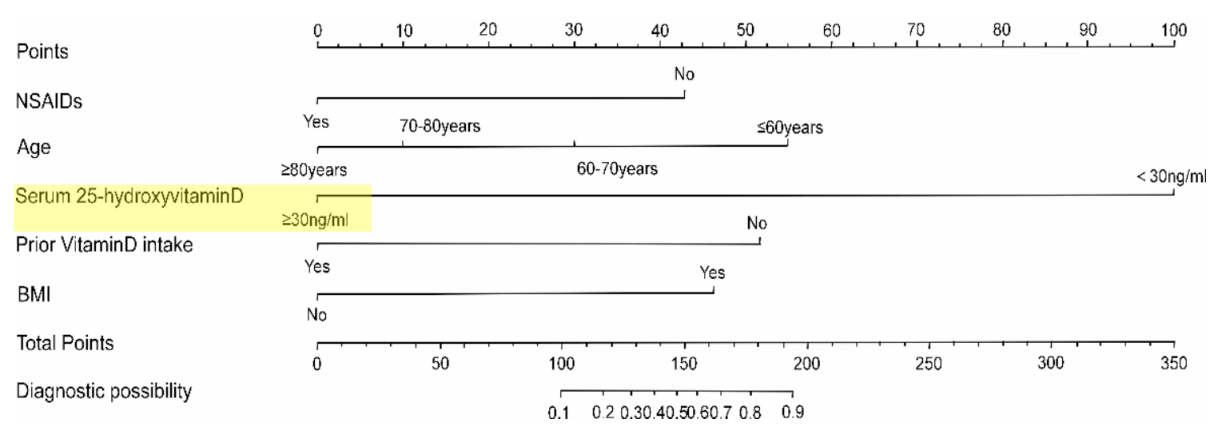Osteoporosis treatment by zoledronic acid painful if low vitamin D (nomogram)
Prediction of musculoskeletal pain after the first intravenous zoledronic acid injection in patients with primary osteoporosis: development and evaluation of a new nomogram
BMC Musculoskeletal Disorders vol 24, #: 841 (2023) https://doi.org/10.1186/s12891-023-06965-y
Xiaoxia Zheng, Jiangnan Ye, Qunzhang Zhan, Weifeng Zhao, Zhongqin Liao, Xiaolin Ye & Chongzheng Qu

Objective
To construct a new prediction nomogram to predict the risk of musculoskeletal pain in patients with primary osteoporosis who receive zoledronic acid intravenously for the first time.
Method
Clinical data of 368 patients with primary osteoporosis who received the first intravenous injection of zoledronic acid in our hospital from December 2019 to December 2022 were studied. Patients were divided into a musculoskeletal pain group (n = 258) and a non-musculoskeletal pain group (n = 110) based on the presence or absence of musculoskeletal pain 3 days after injection. Statistically significant predictors were screened by logistic regression analysis and the minimum absolute contraction and selection operator (LASSO) to construct a nomogram. The nomogram was evaluated by the receiver operating characteristic (ROC) curve, the calibration curve, the C-index, and the decision curve analysis (DCA) and verified in a validation cohort.
Results
The independent predictors of the nomogram were
age,
serum 25-hydroxyvitamin D,
NSAIDs,
prior Vitamin D intake, and
BMI.
The area under the ROC curve (AUC) was 0.980 (95% CI, 0.915–0.987), showing excellent predictive performance. The nomogram c index was 0.980, and the nomogram c index for internal verification remained high at 0.979. Moreover, calibration curves show that the nomogram has good consistency. Finally, the DCA showed that the net benefit of the nomogram was 0.20–0.49.
Conclusion
Musculoskeletal pain is a common symptom of APR in OP patients treated with intravenous zoledronic acid. Risk factors for musculoskeletal pain after zoledronic acid injection in OP patients were: non-use of NSAIDs, youth (<80 years old), serum 25 (OH) D<30ng /mL, no prior intake of vitamin D, BMI<24 kg /m2. A nomogram constructed from the above predictors can be used to predict musculoskeletal pain after the first zoledronic acid injection.
📄 Download the PDF from VitaminDWiki
Wikipedia - How to use a nomogram
VitaminDWiki – Overview Osteoporosis and vitamin D contains
{include}
VitaminDWiki – Osteoporosis category contains
{include}
